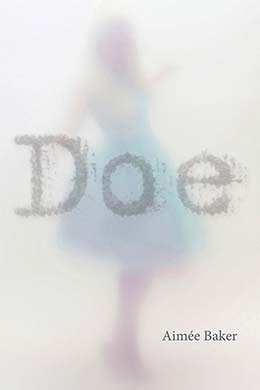Review of Doe
By Aimeé Baker
Akron: The University of Akron Press, 2018
87 pages. $15.95 (Paperback)

When I sit down to read a new book of poems, my immediate urge is to do what most people I know do: flip through the book and look for the poems that catch my eye. Sure, I know that a book of poems is ordered for reading, but that doesn’t stop me. I eventually make it through the entirety of the book in this nonlinear way of first-reading that kind of lets me absorb the book in simultaneity, skipping around to get the overall gist of the book before going through with a sharper, deeper look.
Yet upon opening Aimeé Baker’s debut book of poetry, I found myself unable to skip around like usual. Doe, winner of the 2016 Akron Poetry Prize, is a book of poems about women who have gone missing or whose bodies remain unidentified in the United States, each poem grappling with questions about who these individual women are and what happened to them. And there are lots of women — about seventy-five from cover to cover — each poem labeled with a place, date of disappearance or discovery and a name, where possible. These are poems of witness, bravely facing the gruesomeness of their subjects as they attempt to erase the silence that surrounds these women’s lives and fates. To skip around in this book is to ignore its basic premise — that we must pay attention to these stories.
The book is divided into two sections: Missing and Unidentified, poems for women missing their bodies and women missing their names. Each poem offers a glimpse of a particular woman, encounters that are lush and steeped in violence. The opening poem “The Abduction Narrative” offers the reader an account of what might have happened to Girly Chew Hossencofft, who disappeared from Albuquerque in 1999. Take for example, the third section called “Tour”:
Within a triangle, things are lost. There is a house on the moon where he once told her he has been alive for several thousand years, yet still there is strength in his hands the time he wrapped them around her throat. There is a house where he made love to his creature, her skin glittering under arcs of light. And there is her home, the fiery orange carpet creased with bleach and the goddess of mercy keeping watch. (3)
Throughout the book, where the poems implement narrative, they are also intensely lyrical, and as such they don’t really document the stories of women like Hossencofft in a traditional narrative sense — to be fair, a blow-by-blow recounting of the abduction is probably impractical because the missing pieces of each story, bodies and names that are crucial for an accurate accounting of events. And reliance on narrative would make for poems that are not nearly as rich and deep as those in Doe.
In turning to the lyric, these poems recount the facts of these cases less than they attempt to piece together emotional landscapes for the reader to feel the helplessness, the desolation. For example, in the poem “Light/Dark” for Shelly Kathleen Sikes, missing from Galveston since 1986, we see the girl run off the road and taken from her car, and as she is murdered and buried, the poem shifts its gaze away from the violence being done to her body to clean beaches and fireflies immolating themselves (24). “Magnetic Declination,” for an unidentified woman discovered in Weatherford, Texas in 1998, begins with a meditation about how birds orient themselves during migration before the speaker reveals herself:
My lips and lungsno longer believe in dawn or feast,
and I navigate my body
across grass, the prick
of needle
through fold of arm,
and as birds fall in death, I find fire (69)
In clumsier hands, a book like Doe might come off as gimmicky or voyeuristic or melodramatic — or worse, exploitative of what has befallen these women. In truth, these poems sometimes play with imagery not unlike that of a horror flick. But then the horrific world of Doe is one in which women are in constantly peril of losing their lives, their bodies, their whole selves. Baker’s poems are not cautionary tales or grisly reenactments, but they do remind us that the awful world these women lived in is the same one we live in. They introduce us to those who are gone from the world and ask us to observe their absence, to ask where they are now.
about the author
